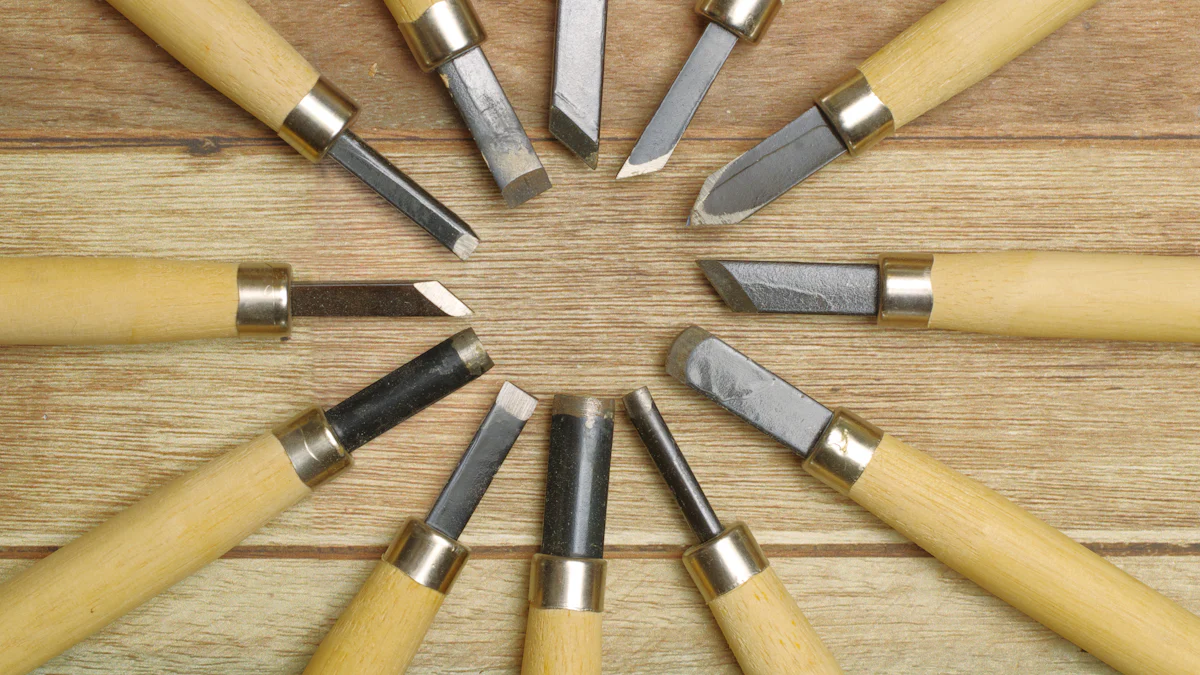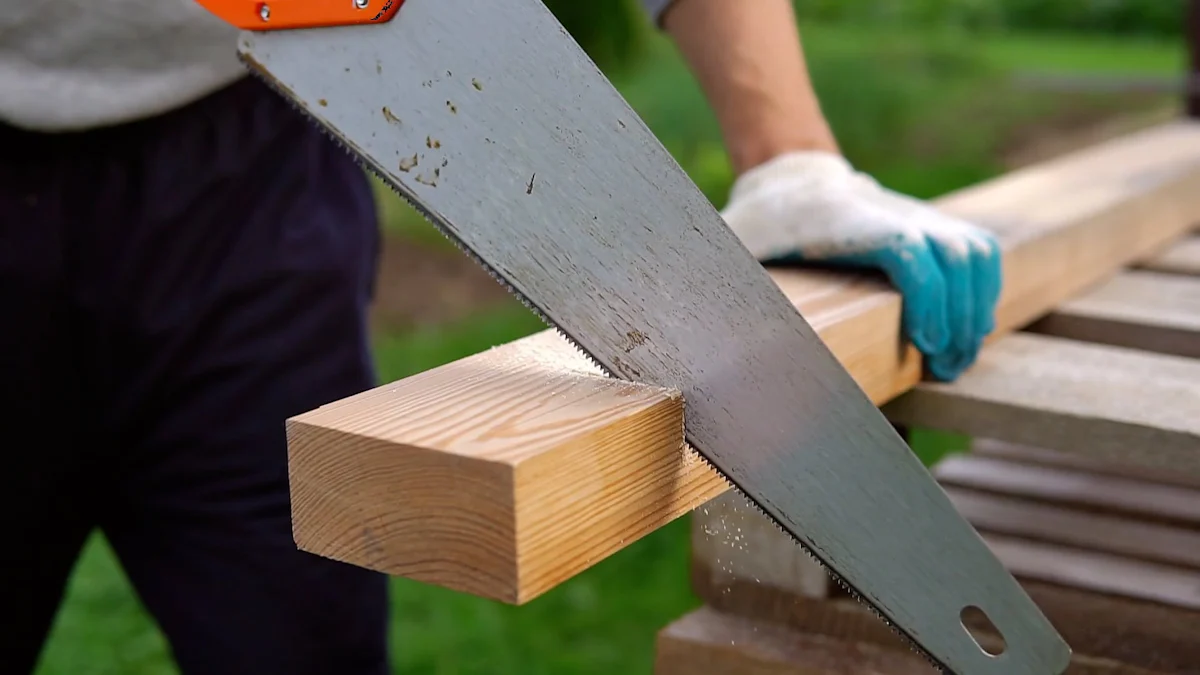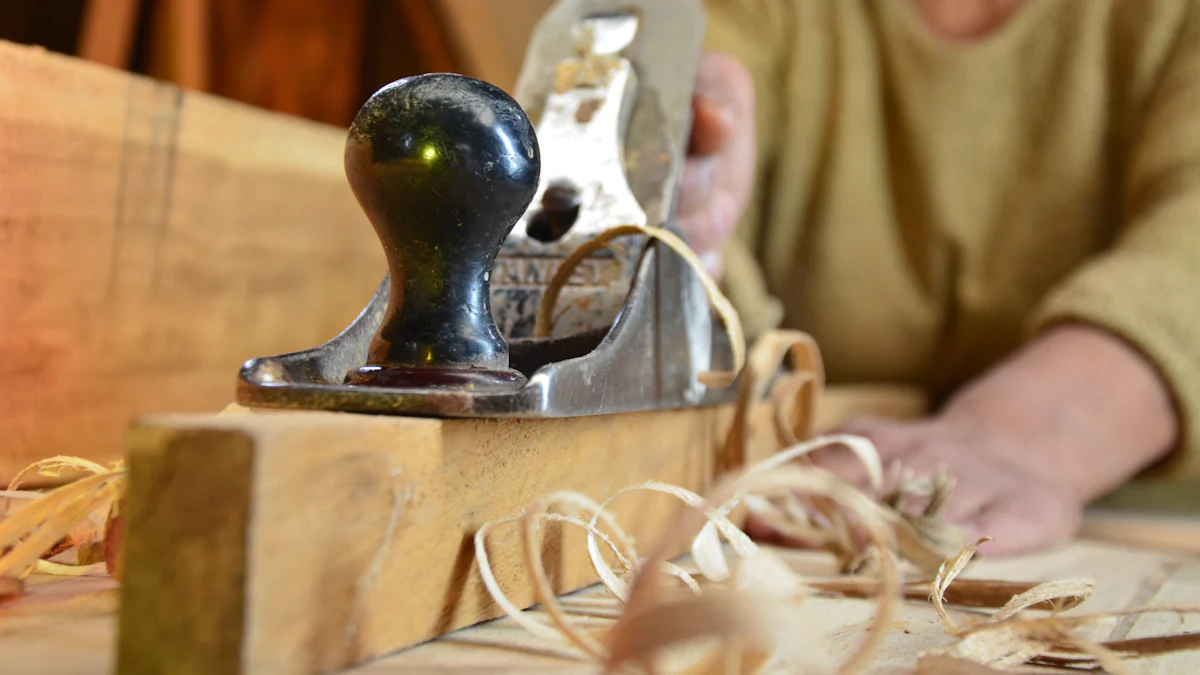
Cutting hand tools play a crucial role in woodworking. Every woodworker needs these tools for planning and sawing processes. Imagine crafting a piece of furniture without the right tools. That would be like painting without a brush. Essential tools help you achieve precision and quality in your projects. These tools become your best friends in the workshop. Investing in the right cutting hand tools ensures success in every woodworking endeavor. So, gear up and get ready to transform wood into art.
Essential Cutting Hand Tools: Saws

Hand Saw
Types of Hand Saws
A hand saw is one of the most basic cutting hand tools you need in your woodworking toolkit. Different types of hand saws serve various purposes. A crosscut saw works best for cutting across the wood grain. The small teeth and slanted edge help make smooth cuts without splintering. A rip saw, on the other hand, is perfect for cutting along the grain. The large teeth make quick work of long cuts. Each type of hand saw has a unique design to tackle specific tasks.
Uses and Benefits
Hand saws offer versatility in woodworking projects. You can use them for tasks like trimming boards or cutting through thick branches. Hand saws provide precision and control, which power tools might lack. The simplicity of a hand saw makes it easy to handle, even for beginners. You don’t need electricity, so you can work anywhere. Hand saws are reliable cutting hand tools that deliver clean results.
Coping Saw
Features of a Coping Saw
A coping saw stands out with its thin blade and U-shaped frame. This design allows for intricate cuts and curves. The blade is easily removable, so you can change it for different materials. A coping saw’s handle offers a comfortable grip, which helps maintain control during detailed work. The tension in the blade ensures accuracy in each cut.
Applications in Woodworking
Coping saws excel in creating intricate shapes and patterns. You can use them for cutting moldings or making dovetail joints. The ability to turn the blade makes it ideal for curved cuts. Coping saws are essential cutting hand tools for any project requiring precision and detail. You can achieve artistic designs with ease using a coping saw.
Backsaw
Characteristics of a Backsaw
A backsaw features a stiff blade supported by a metal or brass back. This structure provides stability and precision. Backsaws include types like the dovetail saw, carcass saw, and tenon saw. Each type serves specific purposes in joinery. The fine teeth on a backsaw ensure smooth, accurate cuts.
Ideal Uses
Backsaws are perfect for making precise joints. You can use them for tasks like cutting dovetails or tenons. The rigid blade helps maintain straight lines, crucial for tight-fitting joints. Backsaws are indispensable cutting hand tools for detailed joinery work. You can rely on a backsaw for accuracy in every cut.
Essential Cutting Hand Tools: Chisels
Chisels are indispensable cutting hand tools in woodworking. You need them for tasks like carving, shaping, and cutting joints. The right chisel can make a big difference in the quality of your work. Let’s dive into two essential types of chisels every woodworker should have.
Bench Chisel
Types of Bench Chisels
Bench chisels come in various styles. You might encounter bevel-edge chisels, which are versatile and handy for most woodworking tasks. Some woodworkers prefer firmer chisels for heavier work. Each type serves a unique purpose, so choose based on your specific needs. A good bevel-edge chisel handles almost any task imaginable. This makes it a popular choice among woodworkers.
How to Use a Bench Chisel
Using a bench chisel requires precision. Hold the chisel firmly and position it at the desired angle. Apply steady pressure to cut or shape the wood. A wooden mallet can help drive the chisel through tougher materials. Practice makes perfect, so spend time honing your skills with these cutting hand tools. You’ll find that a bench chisel becomes an extension of your hand with enough practice.
Mortise Chisel
Features of a Mortise Chisel
A mortise chisel stands out with its thick blade and robust design. This tool excels at cutting deep, square holes known as mortises. The sturdy construction allows you to apply significant force without damaging the chisel. Mortise chisels often feature a long handle for better leverage. This design helps you achieve clean, precise cuts in hardwood.
Specific Uses in Joinery
Mortise chisels are essential for joinery work. You use them to create mortise and tenon joints, which are crucial for strong furniture construction. The ability to cut deep, accurate mortises makes this chisel invaluable. Woodworkers rely on mortise chisels for tasks that require durability and precision. Investing in a quality mortise chisel ensures success in complex joinery projects.
Chisels are vital cutting hand tools in your woodworking arsenal. Whether you’re using a bench chisel or a mortise chisel, these tools offer precision and versatility. Mastering their use enhances your woodworking skills and leads to better results.
Essential Cutting Hand Tools: Planes

Block Plane
Design and Functionality
A block plane is a compact and versatile cutting hand tool. The design includes a low-angle blade that sits at a shallow angle. This setup allows for precise control over the cutting process. Woodworkers appreciate the block plane’s ability to make fine adjustments. The small size makes it easy to handle and maneuver. You can use a block plane for trimming and smoothing wood surfaces.
Common Uses
Block planes excel in tasks that require precision. You can use them to smooth end grain or chamfer edges. The tool works well for fitting joints and adjusting small pieces. A block plane provides clean and accurate cuts, making it a favorite among woodworkers. You can achieve a professional finish on any project with this essential cutting hand tool.
Jack Plane
Characteristics of a Jack Plane
The jack plane serves as a workhorse in the woodworking shop. The tool features a longer body compared to a block plane. This design allows for more substantial material removal. The jack plane’s blade can take deeper cuts, which speeds up the stock removal process. Woodworkers rely on the jack plane for its versatility and efficiency. The tool handles both rough and fine work with ease.
Versatility in Woodworking
Jack planes offer unmatched versatility in woodworking projects. You can use them for flattening boards or preparing stock. The tool excels in jointing edges before gluing panels. A jack plane can also smooth surfaces, leaving a fine finish. Woodworkers value the jack plane for its ability to adapt to various tasks. This cutting hand tool proves indispensable in any woodworking endeavor.
Essential Cutting Hand Tools: Knives
Knives serve as essential cutting hand tools in any woodworking toolkit. These tools offer precision and versatility for various tasks. Let’s explore two types of knives every woodworker should have.
Utility Knife
Features of a Utility Knife
The utility knife stands out as a versatile and practical tool. The compact design makes it easy to handle and store. A sharp, replaceable blade ensures that you always have a fresh edge for cutting. The utility knife often features a retractable blade for safety. This tool provides a comfortable grip, allowing for precise control during use.
Uses in Woodworking Projects
Utility knives excel in tasks requiring precision. You can use them for trimming edges or cutting veneer. The tool works well for scoring materials before making deeper cuts. A utility knife proves invaluable for marking lines on wood. This knife offers the flexibility to work on various materials, making it a must-have in your collection of cutting hand tools.
Carving Knife
Types of Carving Knives
Carving knives come in different shapes and sizes. Each type serves a specific purpose in woodworking. A straight carving knife works best for general carving tasks. The hook knife excels at creating concave shapes. A detail knife allows for intricate work and fine details. Each carving knife type offers unique benefits, so choose based on your project needs.
Techniques for Effective Use
Effective use of a carving knife requires practice. Hold the knife with a firm grip and maintain control over each cut. Use a slicing motion to achieve smooth results. Keep the blade sharp for clean and precise cuts. Experiment with different angles to find the best approach for your project. Mastering these techniques enhances your skills and leads to better results with cutting hand tools.
Knives play a crucial role in woodworking. Whether using a utility knife or a carving knife, these tools provide precision and versatility. Investing in quality knives ensures success in your woodworking endeavors.
Essential Cutting Hand Tools: Files and Rasps
Wood File
Different Types of Wood Files
Wood files stand as essential cutting hand tools for shaping and smoothing wood surfaces. You will find various types of wood files, each designed for specific tasks. Flat files work well for general smoothing. Half-round files offer versatility with their dual surfaces. Round files excel at shaping curves and contours. Each file type provides unique benefits, allowing you to choose the right tool for your project.
Applications in Smoothing and Shaping
Wood files serve a crucial role in woodworking projects. You can use them to refine edges or smooth rough surfaces. The tightly spaced cutting edges provide precision and control. Wood files allow you to achieve a polished finish on your workpieces. These cutting hand tools prove invaluable when finesse and detail are required. Mastering the use of wood files enhances your woodworking skills and results.
Rasp
Characteristics of a Rasp
Rasps offer aggressive cutting capabilities with their raised teeth. These cutting hand tools come in various shapes and sizes. Flat rasps handle broad surfaces effectively. Half-round rasps provide flexibility for different contours. Round rasps excel at creating detailed shapes. The coarse teeth make quick work of material removal, allowing you to shape wood efficiently.
When to Use a Rasp
Rasps prove essential for initial shaping tasks. You can use them to remove large amounts of material quickly. The aggressive cutting action makes them ideal for rough work. Rasps work best before refining the surface with a file. These cutting hand tools allow you to create intricate designs and contours. Learning to use rasps effectively leads to high-quality results in your woodworking projects.
Every woodworker needs the right cutting hand tools. These tools are essential for achieving precision and quality in woodworking projects. You should invest in quality tools to improve your results. Many woodworkers have found that better tools lead to better craftsmanship. A user from finewoodworking.com shared, “I really think the quality of my dovetails has improved since I ditched the Octagonal Sorby’s in favor of the Ashley Iles American Patterns.” Quality tools become trusted companions in your workshop. Embrace these tools and elevate your woodworking skills.
